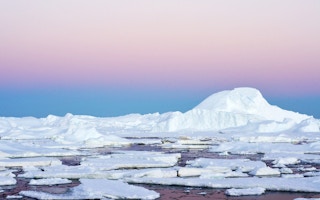It wouldn’t take much to precipitate the complete collapse of the West Antarctic ice sheet, according to new research.
Just a few more decades of ocean warming would be enough to destabilise the relatively small region of ice by the Amundsen Sea − starting a cascade of slipping and sliding that would tip enough ice into the ocean to raise sea levels by three metres. The loss of ice would continue for centuries.
Two scientists at the Potsdam Institute for Climate Impact Research (PIK) in Germany report in the Proceedings of the National Academy of Sciences that they wanted to take a look at the long-term future of the mass of south polar ice that has been worrying researchers for decades.
Planetary temperatures
The West Antarctic ice sheet has already been pronounced as being at the point of no return.
Scientists have calculated that, were the world ever to burn all its fossil fuels, thus increasing levels of atmospheric carbon dioxide and stoking up planetary temperatures, that would be enough to melt the entire Antarctic continent and raise sea levels by 60 metres.
But one of those studies focused on what is happening now; the second looked thousands of years ahead.
The two Potsdam scientists were interested in trying to model the machinery of warmth, wind and weather that could actually complete the long-feared collapse of the ice on and around the West Antarctic peninsula. Right now, the Amundsen Sea ice shelf is precarious, and the glaciers on land are thinning, retreating and accelerating.
“What we call the eternal ice of Antarctica unfortunately turns out not to be eternal at all,” says Earth systems analyst Johannes Feldmann, one of the report’s authors. “Once the ice masses get perturbed, which is what is happening today, they respond in a non-linear way. There is a sudden breakdown of stability after a long period during which little change can be found.
“In our simulations, 60 years of melting at the presently observed rate are enough to launch a process that is unstoppable and goes on for thousands of years. This is certainly a long process. But it’s likely starting right now.”
And his PIK colleague, Anders Levermann, professor of the dynamics of the climate system, says: “So far, we lack sufficient evidence to say whether the Amundsen ice destabilisation is due to greenhouse gases and the resulting global warming. But it is clear that further greenhouse gas emission will heighten the risk of an ice collapse in West Antarctica and more unstoppable sea-level rise.”
Snow accumulation
In a separate study, scientists from the British Antarctic Survey have found that even though the West Antarctic ice sheet is thinning, the snowfalls have become heavier.
Elizabeth Thomas, a palaeoclimatologist, and her colleagues report in Geophysical Research Letters that a study of ice corings revealed that annual snow accumulation increased 30 per cent between 1900 and 2010.
In the last 30 years, the ice sheet gained five metres more frozen water than it did in the first 30 years.
The authors think an increase in the number and intensity of storms in the region could be responsible, and warn that such storms could increase further with climate change.
The same storms that brought more snow inland have also brought warmer ocean currents to the ice shelf, which has then thinned rapidly, even as the fresh loose snow has continued to pile onto the impacted ice of previous decades.
“Thus the increased snowfall we report here has not led to thickening of the ice sheet, but is in fact another symptom of the changes that are driving contemporary ice sheet loss,” said Dr Thomas.










